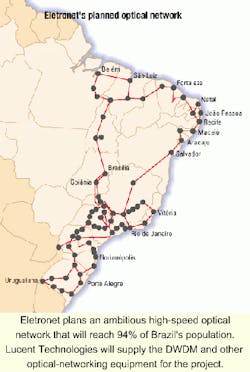Eletronet to build optical network in Brazil
By PETER HOWARD WERTHEIM and DAYSE ABRANTES
Eletronet of Brazil has inked a $180-million contract that calls for Lucent Technologies (Murray Hill, NJ) to provide optical-networking systems for one of the larger and more advanced optical networks to be deployed in Latin America.
Eletronet will build a national optical network based on the electricity infrastructure of Electrobrás, the controller of electricity transmission companies in Brazil, including Chesf, Furnas, Eletrosul, and Eletronorte.
The current composition of Eletronet came about when Lightpar, a subsidiary of Eletrobras, searched for a strategic partner to plan, implement, and manage this new business. In August 1999, AES, a U.S.-based power company, assumed the control and operations of Eletronet by purchasing 51%; Lightpar kept the remaining 49% share.
In the first phase, this network will have 22,000 km (about 14,000 mi) of long-distance and metropolitan access, covering 100 major cities in Brazil in 22 of the 27 Brazilian states "assuring end-to-end communications to our clients," in the words of Elson Lopes, Eletronet's president.
Eletronet will offer the following services: E1 (2-Mbit/sec) circuits, STM-1 (155 Mbits/sec); STM-4 (622 Mbits/sec), STM-16 (2.5 Gbits/sec), STM-64 (10 Gbits/sec), lambdas (including the option to contract for one or more wavelengths in one route), and collocation.
"We know that our project is ambitious, but when the system starts operating, Eletronet will be the main services provider for information traffic in wideband in Brazil, making available the most modern optical solutions," Lopes adds. When the whole Eletronet network starts operating in March 2001, it will surpass the terabit barrier in long-distance communications. The optical network will service 94% of Brazil's 165 million population, a portion responsible for 93% of Brazil's gross domestic product (see Figure).The network architecture will offer total redundancy and use such transmission technologies as SDH, DWDM, and optical ground wire. Such ground wires are designed to substitute for lightning rods in power-transmission networks and have metallic-jacketed optical fibers for data transmission in their core. The advantage of this type of cable is the immunity of optic signals from intense magnetic fields.
Under terms of the agreement, the network will include Lucent's WaveStar 400G DWDM systems operating at a top speed of OC-192 (10 Gbits/sec), which will enable Eletronet's network to transmit approximately 80 million one-page e-mail messages per second. This system will manage a high number of strands of fiber, varying from 24 to 48 fibers in the backbone network and 36 to 144 fibers in the access network.
"This is one of the largest contracts for optical equipment in Latin America and reinforces Lucent's position as one of the global leaders in optical," says Renato Furtado, CEO of Lucent Brazil. Lucent will provide project financing as well as the WaveStar Bandwidth Manager, a high-capacity bandwidth management system.
When Lucent started operating in Brazil in 1997, the company took advantage of pent-up demand for fixed telephone lines. Before the privatization of Brazil's telecommunications system in 1998, Lucent provided 7% of all equipment needed for the cellular sector to operate. With the privatization, Lucent hiked its supply of equipment to 25%, having as clients Telesp Celular, Tele Celular Sul, and Telefonica Celular, all cellular operators.
Lucent has a fiber-optic plant in Campinas in the interior of Sao Paulo State. The company recently inaugurated a $50-million extension of this plant, which represents one-fourth of the amount the company has al ready invested in Brazil during the three years it has been there. During the last nine months, Lucent inked contracts worth $2 billion in several other telecommunications sectors, says Furtado.
Telecom analysts say that many Brazilian operators that did not place advanced orders for fiber-optic cables will have to import because of the huge pent-up demand in the country. In fact, fiber-optic projects that were not yet started or programmed with the producers will have their deployment delayed, say analysts. This factor underscores the importance of Lucent having its own plants producing in Brazil.
While Lucent's international billings overall are growing at a 20% rate per year, the company's billings in Brazil register a growth rate of 100% per year. According to the National Telecommunications Agency (Anatel), the Brazilian government's watchdog over the telecommunications sector, telecommunications in Brazil will have a turnover of $112 billion up to 2005, and Lucent is eagerly eyeing this market.
Peter Howard Wertheim and Dayse Abrantes write on telecom issues in Latin America from Rio de Janeiro.

